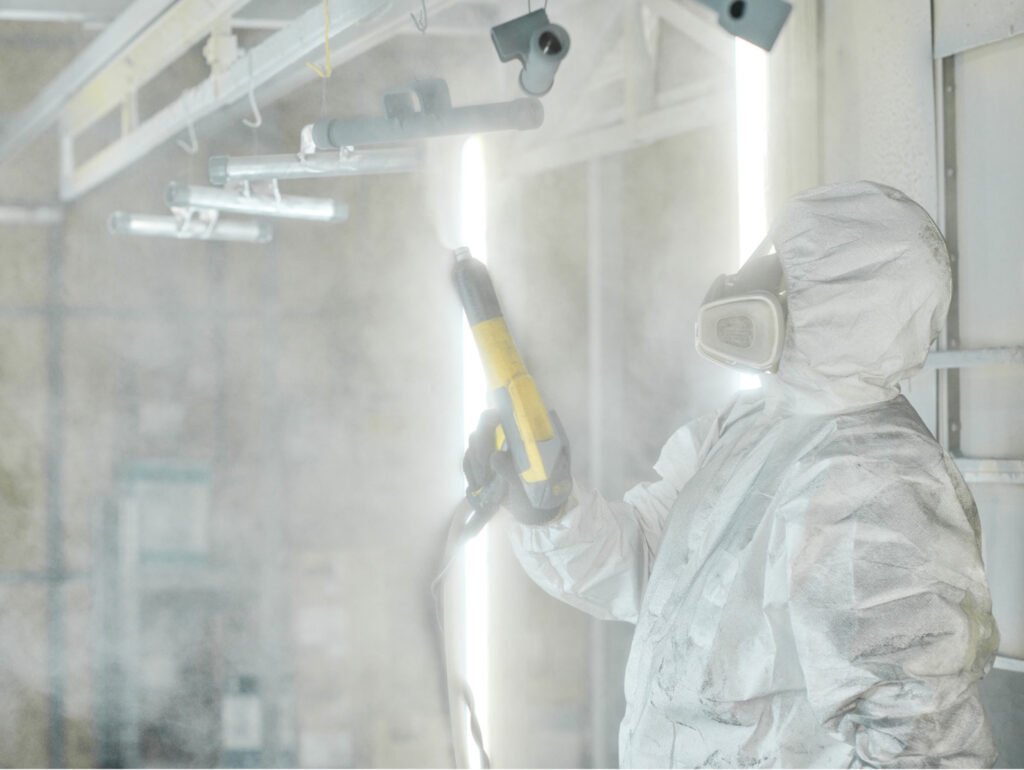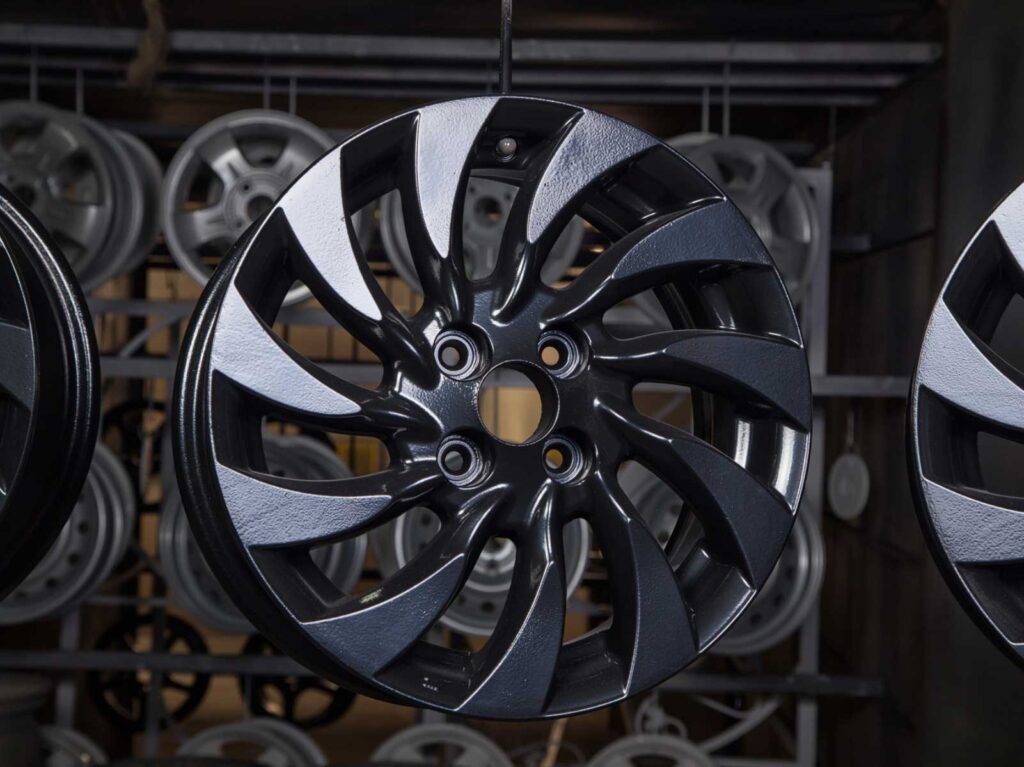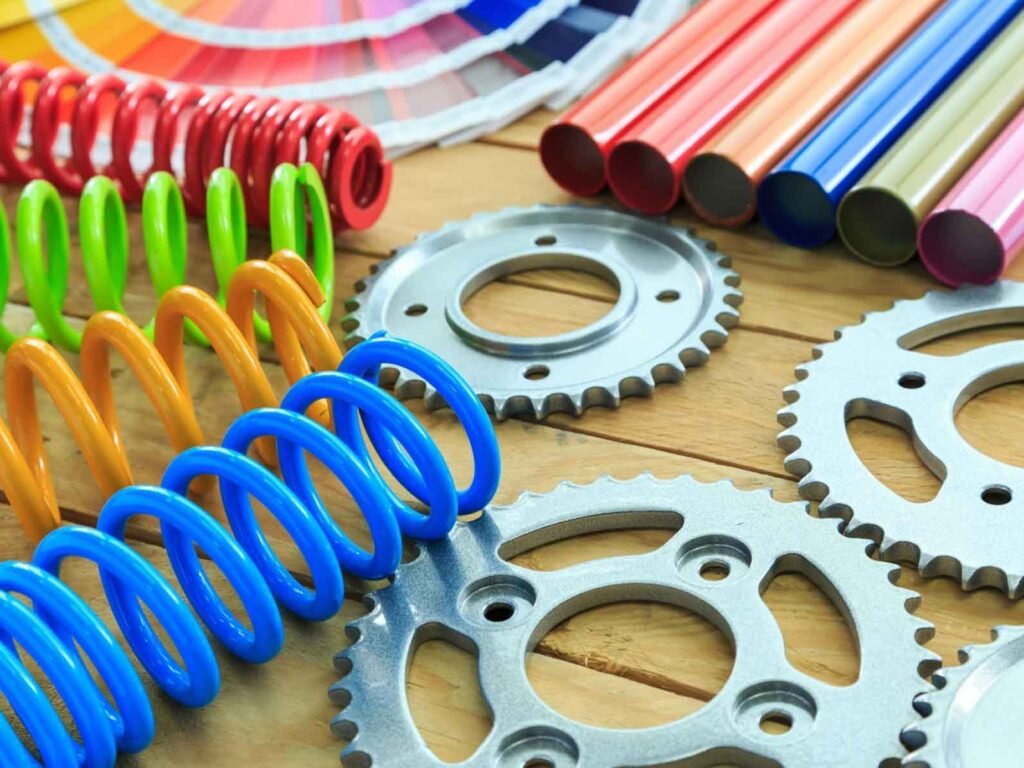In industrial settings, selecting the right protective coating for metals is critical to ensure durability, resistance to corrosion, and cost-effectiveness. Two widely used methods, powder coating and galvanizing, offer distinct advantages depending on the application.
So, which one is better for industrial use? The answer depends on factors like environmental exposure, aesthetic requirements, and budget. Powder coating excels in providing a customizable, attractive finish, while galvanizing is the go-to solution for superior corrosion resistance.
Let’s explore the differences, advantages, and applications of these two coating methods to help you make the best decision for your industrial needs.
What Is Powder Coating?
Industrial coatings must balance durability with visual appeal, but traditional finishes like paint often fail to provide the toughness required in demanding environments.
Powder coating is a finishing process where powdered material is electrostatically applied and cured with heat, forming a durable, scratch-resistant layer.
Powder coating stands out for its versatility in appearance, durability, and eco-friendliness. It creates a seamless barrier that protects metals from corrosion, scratches, and chemicals.
Key Features
- Appearance: Available in various colors, textures, and finishes.
- Durability: Forms a tough layer that resists impact and wear.
- Eco-Friendliness: Contains no VOCs and produces minimal waste.
What Is Galvanizing?
Outdoor and heavy-duty industrial applications require coatings that can withstand corrosion in extreme environments. Traditional methods often fail to provide long-term protection.
Galvanizing is a process where a layer of zinc is applied to metal, typically through hot-dipping, creating a sacrificial coating that protects the base metal.
The zinc coating corrodes before the metal underneath, extending its lifespan and ensuring structural integrity in challenging conditions.
Key Features
- Appearance: Metallic silver or gray finish with a uniform texture.
- Corrosion Resistance: Particularly effective in wet, salty, or harsh outdoor environments.
- Process Simplicity: Quick application, especially for large items like beams or fences.
How Do Powder Coating and Galvanizing Protect Metals?
Corrosion is the leading cause of failure in metal components. Without adequate protection, moisture, chemicals, and UV exposure can weaken structural integrity.
Powder coating protects metals by creating a continuous physical barrier, while galvanizing uses a zinc layer that sacrifices itself to protect the metal underneath.
Powder Coating
- Barrier Protection: Forms an impermeable shield against moisture, chemicals, and UV exposure.
- Limitations: If scratched or chipped, the exposed area can corrode.
Galvanizing
- Sacrificial Protection: Zinc corrodes first, safeguarding the base metal even if the coating is damaged.
- Limitations: Surface roughness or patchy zinc layers may affect appearance but not performance.
Advantages of Powder Coating for Industrial Applications
Industrial environments often require coatings that not only protect but also enhance the appearance of metal components. Traditional finishes like paint may not provide sufficient durability or aesthetic flexibility.
Powder coating offers superior durability, customizable aesthetics, and eco-friendly benefits, making it ideal for many industrial applications.
Key Advantages
- Durability:
- Scratch-resistant and long-lasting, powder coating can withstand moderate wear and tear in industrial environments.
- Its protective barrier resists impacts, chemicals, and general abrasion, making it suitable for equipment and machinery.
- Aesthetic Flexibility:
- Available in a wide range of colors, finishes (matte, gloss, metallic), and textures, allowing customization for decorative or branding purposes.
- Offers a seamless, professional appearance without drips or inconsistencies seen with paint.
- Environmental Benefits:
- Powder coating contains no VOCs, making it safer for operators and the environment.
- Overspray can be reclaimed and reused, minimizing material waste.
- Cost-Effectiveness:
- While the initial cost is slightly higher than paint, its durability reduces the need for frequent maintenance or recoating.
Advantages of Galvanizing for Industrial Applications
Outdoor and heavy-duty applications expose metals to moisture, salt, and harsh chemicals. In such conditions, coatings like paint or powder may fail over time without additional protection.
Galvanizing provides unmatched corrosion resistance, low maintenance, and long-term durability, making it ideal for outdoor and structural applications.
Key Advantages
- Corrosion Resistance:
- Zinc’s sacrificial nature ensures long-term protection, even in wet or salty environments.
- Hot-dip galvanizing offers complete coverage, protecting edges and crevices often missed by other coatings.
- Low Maintenance:
- Once applied, galvanized coatings require little upkeep, saving time and costs over the product’s life cycle.
- Fast Application:
- The hot-dip process allows large structural components to be coated quickly and efficiently.
- Ideal for mass production in industrial settings, such as fencing, pipelines, and bridges.
- Longevity:
- Galvanized coatings often last 20–50 years, depending on the environment, reducing replacement and maintenance costs.
Limitations of Powder Coating
Despite its versatility and aesthetic appeal, powder coating is not suitable for all industrial applications. Its effectiveness depends on the environment and the level of care during application.
Powder coating’s limitations include susceptibility to damage and challenges in high-exposure environments like constant UV or saline conditions.
Key Limitations
- Damage Vulnerability:
- Scratches or chips can expose the base metal to corrosion, especially in aggressive environments.
- Repairing powder-coated surfaces is more complex than touch-ups with paint.
- Heat and UV Sensitivity:
- Without UV-stable additives, prolonged exposure to sunlight can cause fading or degradation.
- High temperatures may compromise the coating’s integrity.
- Complex Application:
- Requires specialized equipment like electrostatic spray guns and curing ovens, which can increase setup costs.
Limitations of Galvanizing
While galvanizing excels in corrosion resistance, its aesthetic and environmental drawbacks make it less ideal for certain applications.
Galvanizing’s limitations include a lack of customization and environmental concerns related to the production process.
Key Limitations
- Limited Aesthetic Appeal:
- The finish is limited to metallic silver or gray, with minimal options for textures or colors.
- This makes galvanizing unsuitable for applications requiring decorative or branding flexibility.
- Surface Texture Issues:
- The zinc layer can appear uneven or patchy, which may not meet the quality standards for visible surfaces.
- Environmental Concerns:
- Chemical pickling and zinc production contribute to pollution, raising concerns about sustainability.
Cost Comparison: Powder Coating vs. Galvanizing
Industrial projects often operate under strict budgets, making cost a key factor in selecting a coating method. While both powder coating and galvanizing offer long-term value, their initial and maintenance costs differ significantly.
Powder coating generally has lower initial costs for smaller projects or decorative applications, whereas galvanizing, though more expensive upfront, offers long-term savings in harsh environments due to its durability and minimal maintenance.
Powder Coating Costs
- Initial Costs: Powder coating is cost-effective for smaller items or projects requiring customization. The equipment cost is higher than painting but lower than galvanizing for similar volumes.
- Maintenance: While durable, powder-coated surfaces in high-stress environments may require occasional touch-ups, adding to lifecycle costs.
- Best Fit: Suitable for projects prioritizing aesthetics and moderate durability at a reasonable cost.
Galvanizing Costs
- Initial Costs: Hot-dip galvanizing incurs higher upfront expenses, especially for large structural items, due to the zinc material and bath process.
- Maintenance: Minimal upkeep reduces long-term expenses, especially for outdoor applications.
- Best Fit: Ideal for large-scale projects requiring corrosion resistance and minimal intervention over decades.
Which Process Is Best for Indoor Applications?
Indoor environments typically prioritize aesthetics and controlled durability over extreme corrosion resistance. Choosing the wrong coating can lead to unnecessary expenses or underwhelming results.
Powder coating is the better option for indoor applications due to its aesthetic versatility and sufficient durability in controlled environments.
Powder Coating for Indoor Use
- Advantages:
- Wide range of colors and finishes enhances visual appeal.
- Provides adequate protection against scratches and mild corrosion in low-moisture settings.
- Ideal Applications: Furniture, appliances, decorative panels, and office equipment.
Galvanizing for Indoor Use
- Advantages:
- Offers durable protection for structural components.
- Suitable for hidden or non-decorative elements like beams and supports.
- Drawbacks:
- Limited aesthetic appeal makes it unsuitable for visible surfaces in most indoor spaces.
Can Powder Coating and Galvanizing Be Combined?
Sometimes, choosing between powder coating and galvanizing is unnecessary. Combining the two processes into a duplex system can deliver the best of both worlds.
Powder coating over galvanized steel enhances durability, corrosion resistance, and aesthetic appeal, making it ideal for demanding industrial and decorative applications.
Duplex Systems
- Process:
- Galvanizing provides the base corrosion resistance.
- Powder coating adds a top layer for visual customization and extra protection.
- Advantages:
- Prolongs the lifespan of components, especially in harsh environments.
- Combines functional and aesthetic benefits for industrial and decorative uses.
- Applications:
- Outdoor furniture, architectural components, and industrial machinery requiring both protection and a polished look.
Conclusion
Powder coating and galvanizing are both excellent choices for protecting industrial components, but the right choice depends on the application. Powder coating excels in aesthetics, indoor use, and cost-effectiveness, while galvanizing offers unparalleled corrosion resistance and durability for outdoor and heavy-duty applications.
Looking for a tailored solution? Contact Tifuls for advanced powder coating options to ensure your projects meet the highest standards of durability and design.





